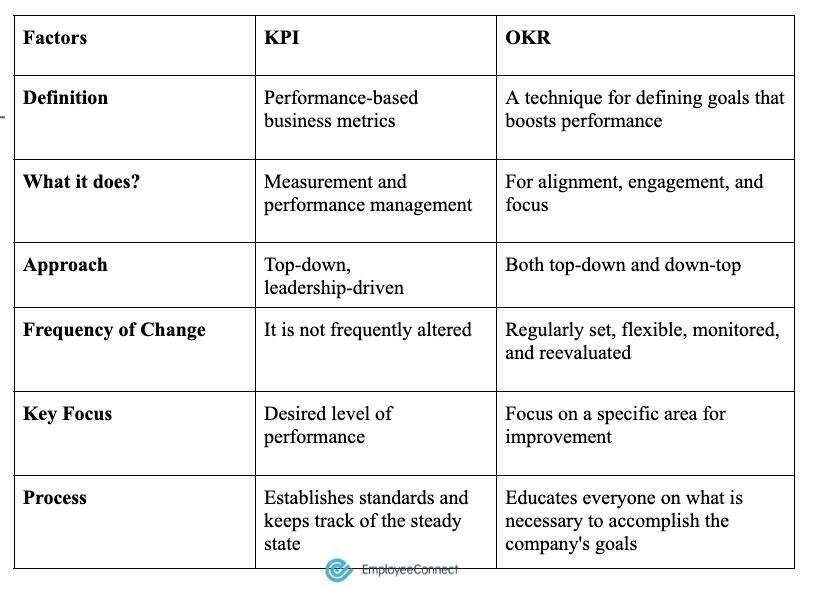
OKR vs KPI, Which One is the Right Fit for Your Company?
Companies have performance metrics to describe and evaluate different projects and processes. OKR vs KPI defines goals and factors to achieve success in an organisation. They are performance measures used to define actions, which can make them appear identical at first. When you look closer, you’ll see that they are quite different.
In this write-up, we analyse the differences between key performance indicators (KPIs) and objectives and key outcomes (OKRs). Once you have a grasp of these performance management frameworks, you can use a combination of them to set smart goals and achieve your business objectives.
What is OKR?
Before we move on to KPI vs OKR, it is important to understand both of them. Objectives and Key Results, or OKRs, outline organisational goals and the key metrics required to assess success. They are high-level objectives that are intended to drive employees and organisations forward.
With the evolving nature of work in recent times, flexibility and structure have become more crucial than ever before. The structure cannot achieve balance with pens and sheets today. That is why, in the expanding 1.5 billion USD OKR software market, OKRs are having their time with the framework serving as the foundation for one of the most successful segments of SaaS.
An example of a general OKR is;
Target: A 30% increase in revenue. The top three key outcomes will be
- Bring in 50 new clients.
- A 20% increase in marketing leads.
- Reach an 85 per cent customer retention rate
What is a KPI?
When analysing OKR vs KPI, we move from OKR to KPI. KPI evaluates a period of performance to achieve a specific objective defined by OKR. The success of various activities, such as projects, programs, or organisational or individual performance, is measured by KPIs.
However, well-assembled KPI indicators can offer much more than a summary of performance. These indicators have the potential to develop into a potent and sophisticated tool to forecast upcoming developments for your company.
You will find unlimited examples of KPIs in any business field. Once you’ve decided on the objective for a project, you start looking for factors to achieve that objective. That is where KPI comes in. To critically evaluate these factors, remember to break down your KPI within several departments unless you have a very small business or project.
Here are a few general KPI examples:
- Within the HR Department: Staff performance, attrition rate, and average recruiting time are examples of KPIs.
- If you want to evaluate the period of performance in the sales department, you should consider looking into the number of sales and profit generated, the number of customers contacted, and the customer lifetime value.
- These factors include treatment fees, educational campaigns, and patient wait time in the healthcare industry.
OKR vs KPI: Similarities and Differences
The purpose for defining goals in OKR vs KPI differs significantly. In contrast to OKR goals, which are a bit more aggressive and ambitious, KPI goals are often attainable and represent the result of an already-existing process or project.

When considering OKR vs KPI, they seem to have a lot of similarities as well.
- They can always be measured.
- Usually, they have three to five major outcomes.
- Both of these performance evaluation factors are timeline based.
- Both of these performance evaluation factors are timeline based.
- These can be utilised on organisational, team, or individual levels.
KPI vs OKR: how to choose the right one for your company?
KPI vs OKR, which one is better? The truth is, both of them are equally important. You must define goals and be clear about your aims before deciding which framework is best for you.
KPIs will work best for you if your company wishes to improve a current project or former initiative. You can adapt the KPIs to your requirements for performance management and track your advancement in real-time.
OKRs are a better choice if your business has more high-level ambitious targets for your business. Those objectives can be divided up into manageable tasks that the entire organisation can participate in. The use of OKRs can also keep your team inspired as you work to achieve your objectives.
It’s crucial to keep in mind that OKR vs KPI isn’t mutually exclusive. To define and measure goals, combine these two frameworks for the best possible business performance.
OKR vs KPI: Goal-Setting implementation suggestions
The differences between OKR and KPI can be used strategically to produce great results. The “O” element of the OKR is your business objective. Brainstorming the high-level objective is your first step in the goal-setting process.
Then, decide what concrete steps you must take to make it happen. Your primary outcomes are these actions. Once you define the objectives, assign KPIs to each of your OKRs to track your progress toward your goal.
KPIs and OKRs can be used in conjunction or independently. For instance, if your goal is to increase customer happiness, your key outcome will be to recruit additional customer care agents and collect customer feedback.
Although you can use OKRs to set any goal, businesses frequently use them to set bolder objectives. For instance, if your business offers software as a service, your OKR might be to dominate the market. You can then collaborate with associated departments to develop several doable strategies to accomplish this goal.
Conclusion
While comparing OKR vs KPI, we have analysed many examples in this article. However, there will be some uncertainties in the actual world. A change in terminology could transform an important outcome into a KPI or vice versa. Knowing the distinction between these two ideas can help your organisation to define goals and apply the right strategies to achieve them.
If you need a HR software to not only increase your HR departments communication throughout the entire organisation but also improve employee engagement, workplace collaboration, employee onboarding and many more tools and benefits sign up for an EmployeeConnect demo.

